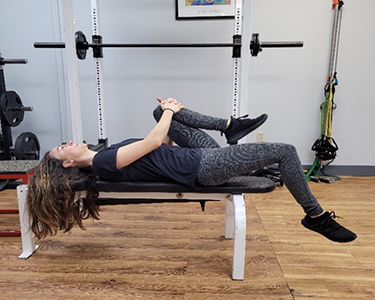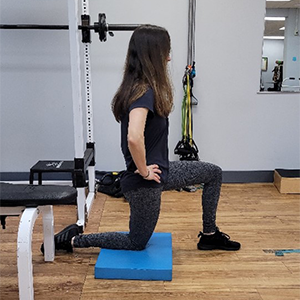
3 Unexpected Reasons to Exercise Your Hips
Leave a CommentHave you ever wondered about the connection between knee pain, back pain, and urinary leakage? The common denominator is your hips! The hip serves as a ball and socket joint, linking the pelvis with the femur’s head (thigh bone). Its primary role is to provide dynamic stability during weight-bearing activities like walking and jogging. Approximately twenty-five muscles attach to the hip. They can be divided up by their primary action: flexors, extensors, abductors, adductors, external rotators and internal rotators.
The Hip’s Role in Back Pain
Many of the hip muscles also share attachment points onto the pelvis or in some cases directly onto the lower back. Limitations in hip range of motion or muscle tightness can affect the lower back and vice versa.
One of these muscles is called the psoas major. It is typically considered a hip muscle because its primary action is flexion at the hip. But it also has attachments to the front of the spine. If this muscle is shortened (or tight) from sitting too much, it can pull on the back and be a source of pain.
You can test this muscle by lying at the end of a bench or table and pulling one knee in towards your chest while you let the other leg relax. If the ‘relaxed’ leg doesn’t touch the table that may indicate tightness in the psoas muscle.

If you find that this muscle is tight, a simple stretch that you can try is the kneeling lunge stretch. Start in a kneeling lunge position, tighten your abdominal muscles, and try to tuck your buttocks in. You should feel a stretch in the front of the hip and thigh that is down. To increase the stretch, simply start to shift your weight forward.

But What About the Knee?
The hip and its surrounding muscles play a crucial role in providing stability during activities such as climbing stairs. Weakness can lead to imbalances, placing increased strain on the knee. The gluteal muscles are key players in “core stability” and should be included in a comprehensive treatment program for knee pain.
Strengthening the hips, specifically hip abduction, has shown to be a valuable tool in alleviating knee pain in individuals with osteoarthritis, as supported by a recent systematic review1. An earlier systematic review concluded that the combination of hip and knee strengthening was more effective than knee strengthening alone in individuals suffering from patellofemoral pain syndrome2.
And Yes, Urinary Leakage Too!
Some of the deep hip muscles overlap with pelvic floor muscles (the key players in maintaining urinary continence). So, it makes sense that strengthening your hips may positively affect urinary symptoms. Exercises like side stepping with a band, seated hip external rotation against resistance and side-lying clamshells benefits your knees and back but can also contribute to improved pelvic health and reduce the risk of urinary incontinence3.
Physical Therapy Can Help
So, exercising your hips not only benefits your knees and back but can also contribute to improved pelvic health and reduce the risk of urinary incontinence. If you have more questions about managing your back pain, knee pain, or urinary leakage, contact your local Athletico clinic and schedule a free assessment. Free assessments are available in-clinic and virtually through our telehealth platform.
*Per federal guidelines, beneficiaries of plans such as Medicare, Medicaid, Tricare, VHA and other federally funded plans are not eligible for free assessments.
The Athletico blog is an educational resource written by Athletico employees. Athletico bloggers are licensed professionals who abide by the code of ethics outlined by their respective professional associations. The content published in blog posts represents the opinion of the individual author based on their expertise and experience. The content provided in this blog is for informational purposes only, does not constitute medical advice and should not be relied on for making personal health decisions.
References:
1. Thomas DT, et al. Hip abductor strengthening in patients diagnosed with knee osteoarthritis – a systematic review and meta-analysis. BMC Musculoskelet Disord. 2022 Jun 29;23(1):622. doi: 10.1186/s12891-022-05557-6.
2. Nascimento LR, Teixeira-Salmela LF, Souza RB, Resende RA. Hip and Knee Strengthening Is More Effective Than Knee Strengthening Alone for Reducing Pain and Improving Activity in Individuals With Patellofemoral Pain: A Systematic Review With Meta-analysis. J Orthop Sports Phys Ther. 2018 Jan;48(1):19-31. doi: 10.2519/jospt.2018.7365. Epub 2017 Oct 15. PMID: 29034800.
3. Marques SAA, et al. Effect of Pelvic Floor and Hip Muscle Strengthening in the Treatment of Stress Urinary Incontinence: A Randomized Clinical Trial. J Manipulative Physiol Ther. 2020 Mar-Apr;43(3):247-256. doi: 10.1016/j.jmpt.2019.01.007.
4. Tuttle LJ, et al. Hip exercises improve intravaginal squeeze pressure in older women. Physiother Theory Pract. 2020 Dec;36(12):1340-1347. doi: 10.1080/09593985.2019.1571142
